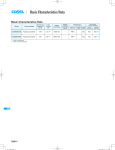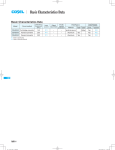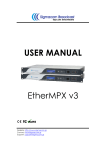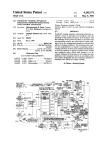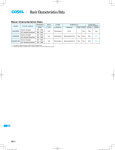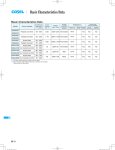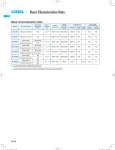Download Basic characteristics data • Instruction manual
Transcript
Basic Characteristics Data Basic Characteristics Data Model Circuit method Switching frequency [kHz] Input current [A] Rated input fuse Inrush current protection circuit Material SNDHS50A Forward converter 470 *1 400V 3.15A - SNDHS50B Forward converter 470 *1 400V 1.6A SNDHS100A Forward converter 470 *1 SNDHS100B Forward converter 470 SNDHS200A Forward converter SNDHS250B Forward converter *1 Refer to Specification. *2 Refer to Instruction Manual. SNDHS SNDHS-14 Series/Parallel operation availability PCB/Pattern Single sided Double sided Series operation Parallel operation FR-4 Yes Yes *2 - FR-4 Yes Yes *2 400V 3.15A - FR-4 Yes Yes *2 *1 400V 1.6A - FR-4 Yes Yes *2 360 *1 400V 5.0A - FR-4 Yes Yes *2 360 *1 400V 3.15A - FR-4 Yes Yes *2 DC-DC Converters Bus Converter . Power Module Value-added Type Instruction Manual 1 Terminal Connection SNDHS-16 2 Connection for Standard Use SNDHS-17 3 Wiring Input/Output Terminal SNDHS-18 4 5 6 7 3.1 Wiring input terminal SNDHS-18 3.2 Wiring output terminal SNDHS-18 Function SNDHS-19 4.1 Overcurrent protection SNDHS-19 4.2 Overvoltage protection SNDHS-19 4.3 Thermal protection SNDHS-19 4.4 Remote ON/OFF SNDHS-19 4.5 Remote sensing SNDHS-19 4.6 Output voltage adjusting SNDHS-20 4.7 Withstanding voltage / Isolation voltage SNDHS-20 Series and Parallel Operation SNDHS-20 5.1 Series operation SNDHS-20 5.2 Redundancy operation SNDHS-20 Implementation-Mounting Method SNDHS-21 6.1 Mounting method SNDHS-21 6.2 Derating SNDHS-21 Option and Others 7.1 Outline of option SNDHS-22 SNDHS-22 SNDHS-15 SNDHS DC-DC Converters Bus Converter . Power Module Value-added Type 1 Terminal Connection Instruction Manual Pin configuration and functions of CN2 (Optional) Pin No. 1 2 Function +RC : +Remote ON/OFF -RC : -Remote ON/OFF ¿SNDHS50A/100A Pin configuration and functions of CN3 Pin No. 1 TB1 2 3 4 CN2 (optional) -M Function : -Self sensing terminal. (Do not wire for -S +S +M external connection.) : -Remote sensing : +Remote sensing : +Self sensing terminal. (Do not wire for external connection.) Mating connectors and terminals on CN2, CN3 1 2 Mating Connector Terminal connector TB2 CN2 B2B-XH-AM XHP-2 CN3 B4B-XH-AM XHP-4 ¿SNDHS200A Mfr. Chain : SXH-001T-P0.6 Loose : BXH-001T-P0.6 Chain : SXH-001T-P0.6 Loose : BXH-001T-P0.6 ¿SNDHS50B/100B CN1 CN2 TB1 4 4 2 1 2 1 CN4 (optional) 1 CN2 (optional) CN3 1 2 2 1 2 4 CN3 (optional) 1 TB2 Fig.1.1 Terminal connection (top view) 1 2 Table 1.1 Terminal connection and function SNDHS No. SNDHS SNDHS 50A/100A 1 2 3 4 5 200A 1 2 3 45 67 Terminal connection +VIN -VIN FG +VOUT -VOUT ¿SNDHS250B CN1 CN5 (optional) CN2 Function +DC input -DC input Frame Ground +DC output -DC output 4 4 2 1 2 1 2 1 CN3 (optional) 1 2 CN4 4 1 1 2 3 4 Fig.1.2 Terminal connection (top view) SNDHS-16 J.S.T. DC-DC Converters Bus Converter . Power Module Value-added Type Table 1.2 Terminal connection and function No. SNDHS SNDHS 50B/100B 1 2 250B 12 34 Terminal +VOUT -VOUT 2 Connection for Standard Use Function connection +DC output -DC output ¡In order to use the power supply, it is necessary to wire as shown in Fig.2.1, Fig.2.2. Pin configuration and functions of CN1 and CN2 Pin No. 1 2 3 4 Function : Remote ON/OFF : -Input Voltage : No connection : +Input Voltage RC1 -VIN NC +VIN Instruction Manual ¿SNDHS50A/100A/200A Heatsink CN1 and CN2 are connected internally. SNDHS50A/100A/200A +VIN +VOUT Pin configuration and functions of CN3:Optional Pin No. 1 2 Function +RC2 : +Remote ON/OFF -RC2 : -Remote ON/OFF Load DC IN -VIN -VOUT Pin configuration and functions of CN4:Optional(SNDHS50B/100B) Pin No. 1 2 Function +RC3 : +Remote ON/OFF -RC3 : -Remote ON/OFF FG Fig.2.1 Connection for standard use ¿SNDHS50B/100B/250B Pin configuration and functions of CN4(SNDHS250B) Pin No. 1 2 3 4 -M Function : -Self sensing terminal. (Do not wire for -S +S +M external connection.) : -Remote sensing : +Remote sensing : +Self sensing terminal. (Do not wire for Heatsink SNDPG750 SNDPF1000 Load AC(N) 50B/100B 250B CN1 CN1 CN2 CN2 CN3 CN3 CN4 CN5 - Connector B3P4-VH Mating connector VHR-4N B2B-XH-AM XHP-2 CN4 B4B-XH-AM XHP-4 RC1 ENA FG FG Heatsink SNDHS50B/100B/250B +VIN Terminal Mfr. Chain : SVH-21T-P1.1 Loose : BVH-21T-P1.1 Chain : SXH-001T-P0.6 Loose : BXH-001T-P0.6 Chain : SXH-001T-P0.6 Loose : BXH-001T-P0.6 -VOUT Fig.2.2 Connection 1 for standard use Mating connectors and terminals on CN1, CN2, CN3, CN4 and CN5 SNDHS SNDHS +VOUT -VIN -VOUT external connection.) Function +RC3 : +Remote ON/OFF -RC3 : -Remote ON/OFF +VIN AC IN Pin configuration and functions of CN5:Optional(SNDHS250B) Pin No. 1 2 SNDHS50B/100B/250B AC(L) +VOUT DC IN +VOUT Load RC1 Vcc -VIN -VOUT SNDHS J.S.T. FG Fig.2.3 Connection 2 for standard use ¡The SNDHS Series handles only the DC input. Avoid applying AC input directly. It will damage the power supply. ¡Operate with the conduction cooling (e.g. heat radiation from the aluminum base plate to the attached heat sink). [Reference: 6.2 ”Derating”] ¡This power supply must be prepared another power supply to the RC1 terminal (as shown in Fig.2.3). [Reference:4.4 “Remote ON/OFF”] ¡If you need except SNDPG750/SNDPF1000 for the input of SNDHS50B/100B/250B, please contact us. *Confirm each specification and instruction manual about the SNDPG/SNDPF series. SNDHS-17 DC-DC Converters Bus Converter . Power Module Value-added Type Instruction Manual Input voltage range Input current [A] 3 Wiring Input/Output Terminal 3.1 Wiring input terminal lp (1) External capacitor on the Input side Input voltage [V] ¡When it turns on an input with a switch directly, one several times the surge voltage of input voltage occurs by the inductance ingre- Fig.3.2 Input current characteristics dient of an input line, and there is a possibility that a power supply DC may break down. YES Please install a capacitor between +VIN and -VIN input terminals SNDHS Load SNDHS Load SNDHS Load and absorb surge. AC SNDHS50B/100B : more than 10 μF SNDHS250B : more than 22 μF NO ¡When the line impedance is high or the input voltage rise quickly at start-up (less than 10us), install a capacitor between +VIN and AC AC /DC YES -VIN input terminals. (2) Input voltage range/Input current range Fig.3.3 Use with AC input ¡The specification of input ripple voltage is shown as below. Ripple voltage SNDHS50A/100A/200A : less than 10Vp-p SNDHS50B/100B/250B : less than 20Vp-p (a) (b) +VIN DC IN -VIN ¡Make sure that the voltage fluctuation, including the ripple voltage, will not exceed the input voltage range. Fig.3.4 Reverse input voltage protection ¡Use a front end unit with enough power, considering the start-up current Ip of this unit. 3.2 Wiring output terminal (3) Operation with AC input ¡The SNDHS series handles only for the DC input. A front end unit(AC/DC unit) is required when the SNDHS series is operated with AC input. (4) Reverse input voltage protection ¡The specified ripple and ripple noise are measured by the method introduced in Fig. 3.5. 0-150mm [0-5.91 inches] SNDHS +VIN +VOUT ¡Avoid the reverse polarity input voltage. It will break the power supply. It is possible to protect the unit from the reverse input voltage by +M +S DC Input voltage range Input voltage [V] Ripple voltage + Co=22mF installing an external diode. SNDHS +VIN DC IN -VIN Load -S -M -VIN Oscilloscope BW:100MHz -VOUT R 1.5m 50W Coaxial Cable C time Fig.3.1 Input voltage ripple t R=50W C=0.01mF +M, +S, -M, -S : SNDHS200A/SNDHS250B Fig.3.5 Method of measuring output ripple and ripple noise SNDHS-18 DC-DC Converters Bus Converter . Power Module Value-added Type 4 Function Instruction Manual + +VIN 4 input - -VIN 2 DC SNDHS External DC 4.1 Overcurrent protection RC1 1 Vcc + ¡Over Current Protection (OCP) is built in and works at 105% of the rated current or higher. However, use in an over current situa- Fig. 4.1 RC1 connection example tion must be avoided whenever possible. The output voltage of the power module will recover automatically if the fault causing over current is corrected. CN1 SW ¡Avoid the reverse polarity input voltage. It will break the power supply. When the output voltage drops after OCP works, the power module enters a ”hiccup mode” where it repeatedly turns on and off at a certain frequency. 4.5 Remote sensing ¿SNDHS250A/SNDHS250B 4.2 Overvoltage protection (1) When Remote Sensing is Not Used ¡Over Voltage Protection (OVP) is built in. When OVP works, output voltage can be recovered by shutting down DC input for at ¡When the power supplies are shipped from a factory, they come with a dedicated short pieces being mounted on CN3 least one second or by turning off the remote control switch (sec- (SNDHS200A), CN4 (SNDHS250B). ondary is an optional) for one second without shutting down the If you do not use the remote sensing function, you can use the DC input. The recovery time varies according to input voltage and power supplies as they are. input capacitance. (2) When Remote Sensing is Used Remarks: Note that devices inside the power module may fail when a voltage greater than the rated output voltage is applied from an exter- ¡When remote sensing is used, please remove the short pieces of CN3, CN4. nal power supply to the output terminal of the power module. This Wire as close as possible could happen in in-coming inspections that include OVP function test or when voltage is applied from the load circuit. OVP can be tested by using the TRM terminal. Consult us for details. SNDHS200A SNDHS250B +S +VOUT -VOUT -S 4.3 Thermal protection + Co Load ¡Over Temperature Protection (OTP) is built in. If the base plate temperature exceeds 100C, OTP will work, causing the output Fig. 4.2 When remote sensing is used ((SNDHS200A/SNDHS250B) voltage to drop. Output voltage can be recovered by shutting ¡Using remote sensing with long wires may cause output voltage to become unstable. Consult us if long sensing wiring is necessary. down DC input for at least one second or by turning off the remote control switch (secondary is an optional) for one second without shutting down the DC input. ¡Sensing patterns or wires should be as short as possible. If wires are used, use either twisted-pair or shielded wires. 4.4 Remote ON/OFF ¡Use wide PCB patterns or thick wires between the power supply and the load. Line drop should be kept less than 0.3V. Make sure ¡Please contact us about remote control of an optional. output voltage from the power supply stays within the specified range. ¡If the sensing patterns are shorted by mistake, a large current may flow and damage the pattern. This can be prevented by installing ¿SNDHS50B/100B/250B ¡This power supply must be prepared another power supply to the RC1 terminal. fuses or resistors close to the load. ¡The remote ON/OFF function is incorporated in the input circuit and operated with RC1 and -VIN. fluctuations in output voltage, make sure enough evaluation is As wiring or load impedance may generate oscillation or large given in advance. Table 4.1 Remote ON/OFF specifications Between RC1 and -VIN (Vcc) L level (0 - 1.2V) or Open H level (3.5 - 12V) Output Voltage OFF ON ¡When RC1 is at High level, a current of 13mA max will sink in. SNDHS-19 SNDHS DC-DC Converters Bus Converter . Power Module Value-added Type 4.6 Output voltage adjusting ¡Output voltage can be adjusted by internal potentiometer. To increase an output voltage, turn a built-in potentiometer clockwise. Instruction Manual 5 Series and Parallel Operation To decrease the output voltage, turn it counterclockwise. ¡When the input voltage is 60-66VDC or 200-250VDC, the output voltage adjustment range becomes as shown in Fig.4.3. 100 90 60 63 66 Input voltage [V] SNDHS50A/100A 110 Others 100 connection should be lower than the lowest rated current in each unit. (a) Power Supply 90 0 0 60 63 66 Input voltage [V] Load 110 0 0 ¡Series operation is available by connecting the outputs of two or more power supplies, as shown below. Output current in series 5V Adjustment range [%] Adjustment range [%] 5V,12V,15V,24V 5.1 Series operation Power Supply SNDHS200A (b) Load Power Supply Others 100 90 0 0 200 225 Load Adjustment range [%] 3.3,5V 110 Power Supply 250 Input voltage [V] Fig. 4.3 Output voltage adjustment range 4.7 Withstanding voltage / Isolation voltage ¡When testing the withstanding voltage, make sure the voltage is increased gradually. When turning off, reduce the voltage gradually by using the dial of the hi-pot tester. Do not use a voltage tester with a timer as it may generate voltage several times as large as Fig. 5.1 Examples of series operation 5.2 Redundancy operation ¡Parallel operation is not possible. ¡Redundancy operation is available by wiring as shown below. I1 I3 +VOUT -VOUT Load SNDHS50B/100B/250B the applied voltage. I2 +VOUT -VOUT SNDHS Fig. 5.2 Example of redundancy operation ¡Even a slight difference in output voltage can affect the balance between the values of I1 and I2. Please make sure that the value of I3 does not exceed the rated current of a power supply. I3 SNDHS-20 the rated current value DC-DC Converters Bus Converter . Power Module Value-added Type 6 ImplementationMounting Method Instruction Manual ¿SNDHS50A/100A/200A Specifications for ripple and ripple noise changes in the shaded area. 6.1 Mounting method ¡The unit can be mounted in any direction. When two or more power supplies are used side by side, position them with proper Load factor [%] 100 intervals to allow enough air ventilation. Aluminum base plate temperature (Point A) around each power supply should not exceed 2 1 3 1SNDHS50A/100A 2SNDHS200A05 3SNDHS200A12, 15, 24 70 50 15 0 -20 0 20 40 60 (70) 80 9095 Temperature of measureing point (Point A) [C] the temperature range shown in derating curve (Fig6.2, Fig.6.4). ¡In case of metal chassis, keep the distance between d1 for to insulate between lead of component and metal chassis, use the TB2 TB1 spacer of 4mm[0.16 inches] or more between d1. If it is less than d1, insert the insulation sheet between power supply and metal d1 chassis. Point A Measuring Point d1 Fig.6.2 Derating curve (Point A) d1 d1 Load factor [%] 100 50 d1 0 - 20 d1=4mm [0.16 inches] min. -10 0 10 20 30 40 50 60 70 Temperature of measureing point (Point B) [C] Figure is SNDHS250B Fig.6.1 Mounting method 6.2 Derating TB1 ¡Use with the conduction cooling (e.g. heat radiation by conduction from the aluminum base plate to the attached heat sink). SNDHS Fig.6.2, Fig.6.4 shows the derating curve based on the aluminum Point B Measuring Point base plate temperature. In the hatched area, the specification of Ripple and Ripple Noise is different from other areas. ¡Please measure the temperature on the aluminum base plate edge side (Point A). ¡Please consider the ventilation to keep the temperature on the PCB (Point B) less than the temperature of Fig.6.3., Fig.6.5. ¡It is necessary to note the thermal fatigue life by power cycle. Please reduce the temperature fluctuation range as much as possible when the up and down of the temperature are frequently TB2 Figure is SNDHS200A generated. Contact us for more information on cooling methods. Fig.6.3 Derating curve (Point B) SNDHS-21 DC-DC Converters Bus Converter . Power Module Value-added Type ¿SNDHS50B/100B/250B Specifications for ripple and ripple noise changes in the shaded Instruction Manual 7 Option and Others area. Load factor [%] 100 2 1 3 1SNDHS50B 2SNDHS100B 3SNDHS250B 70 50 15 0 -20 0 20 40 7.1 Outline of option ¿ -C -Option -C units have coated internal PCB for better moisture resistance. 60 (70) 80 9095 ¿ -R (SNDHS50A, SNDHA100A,SNDHS200A) -You can control output ON/OFF remotely in Option -R units. To do so, connect an external DC power supply and apply a volt- Temperature of measureing point (Point A) [C] age to a remote ON/OFF connector, which is available as opTB1 CN2 tion. Model Name Built-in Resistor Ri [ W ] Voltage between +RC Input and -RC [V] Current [mA] ENA ON ENA OFF SNDHS50A, Point A SNDHS100A, Measuring Point 1200 3.5 - 12 0 - 0.5 10max SNDHS200A Fig.6.4 Derating curve (Point A) R*1 Load factor [%] 100 External Power Source SW +RC 1 Inside of a Power Supply Ri Input Current -RC 2 50 Remote ON/OFF connector (Optional) Fig.7.1 Example of using a remote ON/OFF circuit 0 - 20 -10 0 10 20 30 40 50 60 Temperature of measureing point (Point B) [C] CN1 70 -Dedicated harnesses are available for your purchase. Please see Optional Parts for details. *1 If the output of an external power supply is within the range of 3.5 - 12V, you do not need a current limiting resistor R. If CN2 the output exceeds 12V, however, please connect the current limiting resistor R. To calculate a current limiting resistance value, please use the following equation. SNDHS R[W]= Point B Vcc-(1.1+RiX0.005) 0.005 Measuring Point *Please wire carefully. If you wire wrongly, the internal components of a unit may be damaged. ¡Remote ON/OFF circuits (+RC and -RC) are isolated from input, output and FG. TB1 Figure is SNDHS250B Fig.6.5 Derating curve (Point B) SNDHS-22 DC-DC Converters Bus Converter . Power Module Value-added Type ¿ -R (SNDHS50B, SNDHA100B,SNDHS250B) -The output can be turned on without external power source. -When short circuit piece is not mounted on RC3, various remote control is available. Instruction Manual *Please wire carefully. If you wire wrongly, the internal components of a unit may be damaged. ¡Remote ON/OFF circuits (+RC2 and -RC2 only) are isolated from input, output and FG. Case 1:When short circuit piece is mounted on RC3, the output can be turned on by applying input voltage (external power source to the remote control circuit is unnecessary). When the power supplies are shipped from a factory, they come with a dedicated short circuit piece mounted on RC3. Case 2:When short circuit piece is mounted on RC3, the output (ON/OFF) can be controlled by making open/short RC3. Case 3:When short circuit piece is not mounted on RC3, the output (ON/OFF) can be controlled by external power source to remote control circuit RC1 and RC2. CASE RC3 RC1 RC2 OUTSIDE OF INSIDE OF SHORT RC3 DC DC OUTPUT POWER SUPPLY POWER SUPPLY CIRCUIT VOLTAGE VOLTAGE PIECE 1 RC1 -Vin 1 mounted Short - - 2 Ri1:750W 1 Ri2:1200W +RC2 ON -RC2 2 1 Short Circuit piece +RC3 -RC3 2 1 RC1 ON Short 1.2[V] 2 0.5[V] +RC2 or less or less -RC2 Open R1*1 12[V] 3 Open ON Vcc DC Voltage 3.5 ~ Vcc DC Voltage 0.5[V] or less OFF 2 2 1 RC1 -Vin R2*1 12[V] Ri2:1200W +RC3 -RC3 3.5 ~ Ri1:750W 1 1 OFF not mounted 2 -Vin +RC2 -RC2 2 Ri1:750W 1 Ri2:1200W 2 1 +RC3 -RC3 SNDHS 2 Fig.7.2 Example of using a remote ON/OFF circuit. -Dedicated harnesses are available for your purchase. Please see Optional Parts for details. *1 If the output of an external power supply is within the range of 3.5 - 12V, you do not need a current limiting resistor R1, R2. If the output exceeds 12V, however, please connect the current limiting resistor R1, R2. To calculate a current limiting resistance value, please use the following equation. R1, R2[W]= Vcc-(1.1+Ri1,Ri2X0.005) 0.005 SNDHS-23











